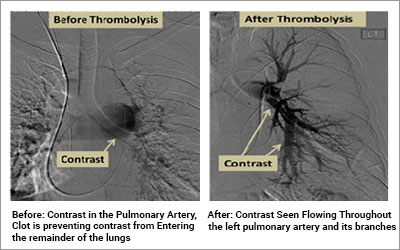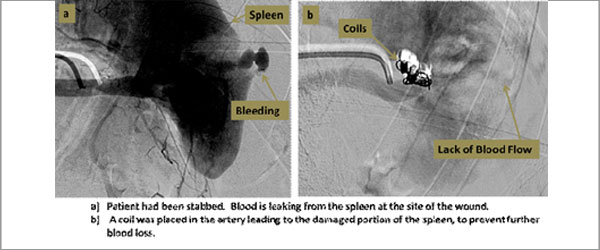

Arterial Thrombolysis
Acute occlusion of an artery by clot
Clot can form locally in an artery and block it (thrombosis), or clot can form elsewhere in the body and be carried in the bloodstream until it lodges in a distant artery (embolism). The blockage by the clot prevents normal blood flow to the organ served by the artery, which can result in ischemia (tissue starvation) or necrosis (tissue death)
local
Bleeding, infection, damage to the artery wall (rupture or dissection). Clot or plaque can break off during the intervention and pass down toward the foot, limiting flow (distal embolization). In most cases, these complications can be recognized and treated during the procedure. Rarely, open surgery or even amputation may be required.
Bleeding, infection, damage to the artery wall (rupture or dissection). Clot or plaque can break off during the intervention and pass down toward the foot, limiting flow (distal embolization). In most cases, these complications can be recognized and treated during the procedure. Rarely, open surgery or even amputation may be required.
Doppler ultrasound and clinic visit is typically performed several weeks after the procedure to confirm that the artery remains open and that symptoms have improved. Continued follow-up depends on the individual case.
Embolization
Internal bleeding, aneurysms, abnormal blood vessels, gastrointestinal bleeding, vascular malformations (Arteriovenous malformations, Venous and Lymphatic Malformations)
Embolization procedures allow blockage of blood vessels without invasive surgery. Embolization can be used to stop arterial bleeding, and can also be used to block blood vessels for other reasons, such as to treat tumors, shrink vascular malformations, or re-direct flow.
An interventional radiologist accesses the femoral artery at the groin. Small catheters and wires are used to navigate into the chosen artery, confirmed with angiography. An occluding substance can then be injected, or small coils can be placed into the artery to block the vessel.
local
Bleeding, infection, non-target embolization (blockage of an artery other than the one intended)
Two to six hours of bed rest
Depends on the clinical situation




